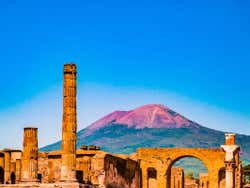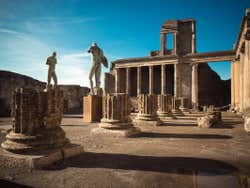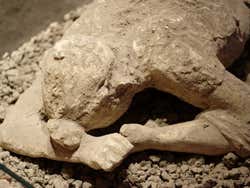
Pompeii
Pompeii was an ancient Roman city that was buried alive in the enormous volcanic eruption of Mount Vesuvius in 79 AD. Discover its fascinating history!
A window to the past
In the first century, Pompeii was a thriving colony of the Roman Empire that was home to a population of up to 20,000 people. That is, until the year 79 AD when nearby Mount Vesuvius violently erupted and destroyed the entire city.
Alongside neighbouring Herculaneum, Pompeii and its inhabitants were buried alive under more than 20 feet (6 metres) of volcanic ash. Forgotten under volcanic debris for over 1700 years, the ancient city was re-discovered in the mid-18th century by an architect building a canal. Since then, excavations have uncovered an incredibly well-preserved snapshot into Greco-Roman life.
What to see in Pompeii?
While archaeological work is still ongoing to discover more of the site, and not all of the 100-odd acres already excavated are open to the public, there is more than enough to see. From ancient residents preserved in their last moments of fear to temples to erotic graffiti, you'd need days to take in everything. Here are our highlights:
- Forum: the heart of political, social and religious life in Pompeii and every Ancient Roman city, the large open space and columns of the Forum are a must-see.
- Sanctuary of Apollo: one of the oldest places of worship in Pompeii, the temple dedicated to the sun god remains one of the most fascinating places to visit.
- Lupanar: one of the most striking areas of Pompeii is this ancient brothel, whose simple rooms are still decorated with erotic paintings advising customers of the activities that took place there.
- Orto dei fuggiaschi: the "Garden of the Fugitives" will have your hair standing up on end: the casts of 13 victims of the volcanic eruption are displayed here, buried in preserving ash as they tried to escape the lava flow from Vesuvius.
- Teatro Grande: built around the 2nd century BC, this large theatre had room for more than 5000 spectators and is unbelievably well-preserved.
- House of the Faun: one of the largest and most luxurious houses in Pompeii, a statue of a dancing faun, or satyr, gives this mansion its name.
How to get to Pompeii?
There are a few different ways to get to Pompeii from Naples:
- Organised tour: this is the most stress-free way to get to Pompeii, and includes hotel pickup and drop off, transport, an official English-speaking guide and skip-the-line entrance for € 60 (US$ 67.95). Book our Day Trip to Pompeii.
- Train: catch the Sorrento or Poggiomarino Circumvesuviana train from Naples and get off at Pompei Scavi Villa dei Misteri or Pompei Santuario. The journey takes between 30 to 40 minutes and costs around € 3 (US$ 3.39).
- Rental car: this option can turn out to be cheaper and easier if you're travelling as a group and have other excursions planned to nearby sites. Check out our car hire prices here.
A must-see
If you're travelling to Naples, taking a day to visit Pompeii is a must-do experience. It's incredible to see such a well-preserved example of life as it was almost 2000 years ago, a lively city stuck in time in what is still one of the most devastating volcanic eruptions in Europe's history.




Schedule
From November 1st to March 31st: Every day from 9:00 a.m. to 5:00 p.m.
From April 1st to October 31st: Every day from 9:00 a.m. to 7:00 p.m.
Closed: January 1st, May 1st, and December 25th.
Price
Adults: € 22 (US$ 24.91).
EU citizens aged 18-25: € 2 (US$ 2.26).
EU citizens under 18 and over 65: free admission.
Day Trip to Pompeii € 65 (US$ 73.61)
Nearby places
Mount Vesuvius (9.3 km) Positano (13.1 km) Castel dell'Ovo (20.1 km) Castel Nuovo (20.3 km) Royal Palace of Naples (20.4 km)

